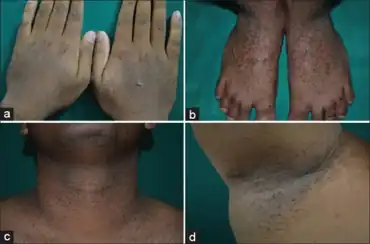Reticulate acropigmentation of Kitamura
| Reticulate acropigmentation of Kitamura | |
|---|---|
 | |
| Reticulate hyperpigmentation on: a) Dorsa of both hands b) Dorsa of both feet c) Neck d) Axilla | |
| Specialty | Dermatology |
| Symptoms | Colored freckle-like and slightly depressed spots arranged in a lace-like pattern on the backs of hands and feet[1] |
| Usual onset | Adolescence and young adults[1] |
| Causes | Autosomal-dominant[1] |
| Differential diagnosis | Dowling–Degos disease[1] |
| Frequency | Rare[1] |
Reticulate acropigmentation of Kitamura (RAK), is a type of pigmentation disorder of the skin.[1] It presents with colored freckle-like and slightly depressed spots arranged in a lace-like pattern on the backs of hands and feet.[1] It tends to occur in skin folds of adolescents and early adulthood, and darkens over time.[1]
It is inherited in an autosomal-dominant fashion.[1]
The condition is rare.[2] It was first described in Japan, before recognising that is also occurs elsewhere.[1]
Signs and symptoms
.png.webp) Hyperpigmented macules of forearms
Hyperpigmented macules of forearms.png.webp) Freckle-like marks on back of hands
Freckle-like marks on back of hands.png.webp) Fine pitting of the palms
Fine pitting of the palms
Diagnosis
.png.webp) Increased melanization of the basal layer with slightly atrophic epidermis (H and E, ×40)
Increased melanization of the basal layer with slightly atrophic epidermis (H and E, ×40)
Genetics
This condition is associated with mutations in the a disintegrin and metalloproteinase domain-containing protein 10 (ADAM10) gene. This association was first shown in 2013.
See also
References
- 1 2 3 4 5 6 7 8 9 10 James, William D.; Elston, Dirk; Treat, James R.; Rosenbach, Misha A.; Neuhaus, Isaac (2020). "36. Disturbances of pigmentation". Andrews' Diseases of the Skin: Clinical Dermatology (13th ed.). Edinburgh: Elsevier. p. 867. ISBN 978-0-323-54753-6. Archived from the original on 2023-07-01. Retrieved 2023-05-04.
- ↑ "Orphanet: Reticulate acropigmentation of Kitamura". www.orpha.net. Archived from the original on 25 November 2020. Retrieved 23 April 2019.
External links
| Classification | |
|---|---|
| External resources |
|
This article is issued from Offline. The text is licensed under Creative Commons - Attribution - Sharealike. Additional terms may apply for the media files.